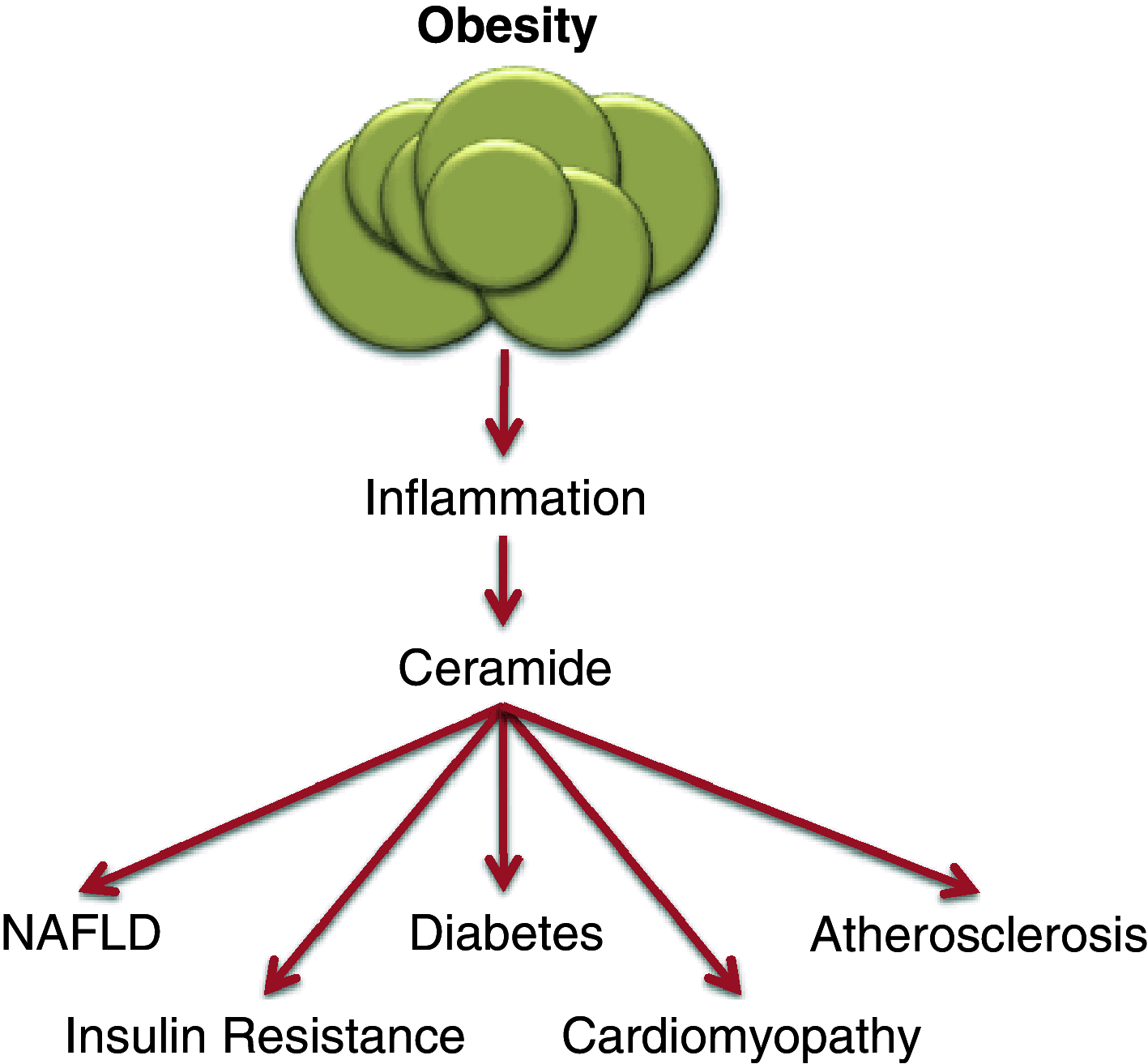A role for sphingolipids in the pathophysiology of obesity-induced inflammation
- PMID: 22294100
- PMCID: PMC11114706
- DOI: 10.1007/s00018-012-0917-5
A role for sphingolipids in the pathophysiology of obesity-induced inflammation
Abstract
Following the initial discovery that adipose tissue actively synthesizes and secretes cytokines, obesity-induced inflammation has been implicated in the etiology of a host of disease states related to obesity, including cardiovascular disease and type II diabetes. Interestingly, a growing body of evidence similarly implicates sphingolipids as prime instigators in these same diseases. From the recent discovery that obesity-related inflammatory pathways modulate sphingolipid metabolism comes a novel perspective—sphingolipids may act as the dominant mediators of deleterious events stemming from obesity-induced inflammation. This paradigm may identify sphingolipids as an effective target for future therapeutics aimed at ameliorating diseases associated with chronic inflammation.
Figures





Similar articles
-
Adipose tissue and ceramide biosynthesis in the pathogenesis of obesity.Adv Exp Med Biol. 2011;721:67-86. doi: 10.1007/978-1-4614-0650-1_5. Adv Exp Med Biol. 2011. PMID: 21910083 Review.
-
Specific Hepatic Sphingolipids Relate to Insulin Resistance, Oxidative Stress, and Inflammation in Nonalcoholic Steatohepatitis.Diabetes Care. 2018 Jun;41(6):1235-1243. doi: 10.2337/dc17-1318. Epub 2018 Mar 30. Diabetes Care. 2018. PMID: 29602794
-
Sphingolipids and hepatic steatosis.Adv Exp Med Biol. 2011;721:87-97. doi: 10.1007/978-1-4614-0650-1_6. Adv Exp Med Biol. 2011. PMID: 21910084 Review.
-
Sphingolipids, insulin resistance, and metabolic disease: new insights from in vivo manipulation of sphingolipid metabolism.Endocr Rev. 2008 Jun;29(4):381-402. doi: 10.1210/er.2007-0025. Epub 2008 May 1. Endocr Rev. 2008. PMID: 18451260 Free PMC article. Review.
-
Targeting sphingolipid metabolism in the treatment of obesity/type 2 diabetes.Expert Opin Ther Targets. 2015;19(8):1037-50. doi: 10.1517/14728222.2015.1028359. Epub 2015 Mar 26. Expert Opin Ther Targets. 2015. PMID: 25814122 Review.
Cited by
-
Ceramide as a mediator of non-alcoholic Fatty liver disease and associated atherosclerosis.PLoS One. 2015 May 20;10(5):e0126910. doi: 10.1371/journal.pone.0126910. eCollection 2015. PLoS One. 2015. PMID: 25993337 Free PMC article.
-
Ceramides and Cardiovascular Risk Factors, Inflammatory Parameters and Left Ventricular Function in AMI Patients.Biomedicines. 2022 Feb 11;10(2):429. doi: 10.3390/biomedicines10020429. Biomedicines. 2022. PMID: 35203637 Free PMC article.
-
Possible Therapeutic Application of Targeting Type II Natural Killer T Cell-Mediated Suppression of Tumor Immunity.Front Immunol. 2018 Feb 22;9:314. doi: 10.3389/fimmu.2018.00314. eCollection 2018. Front Immunol. 2018. PMID: 29520281 Free PMC article. Review.
-
Ketones Elicit Distinct Alterations in Adipose Mitochondrial Bioenergetics.Int J Mol Sci. 2020 Aug 29;21(17):6255. doi: 10.3390/ijms21176255. Int J Mol Sci. 2020. PMID: 32872407 Free PMC article.
-
Sphingolipids and lifespan regulation.Biochim Biophys Acta. 2014 May;1841(5):657-64. doi: 10.1016/j.bbalip.2013.08.006. Epub 2013 Aug 15. Biochim Biophys Acta. 2014. PMID: 23954556 Free PMC article. Review.
References
-
- Finkelstein EA, Trogdon JG, Cohen JW, Dietz W. Annual medical spending attributable to obesity: payer-and service-specific estimates. Health Aff (Millwood) 2009;28:w822–w831. - PubMed
-
- Fontaine KR, Redden DT, Wang C, Westfall AO, Allison DB. Years of life lost due to obesity. JAMA. 2003;289:187–193. - PubMed
-
- Flegal KM, Graubard BI, Williamson DF, Gail MH. Cause-specific excess deaths associated with underweight, overweight, and obesity. JAMA. 2007;298:2028–2037. - PubMed
-
- Thevissen K, Francois IE, Winderickx J, Pannecouque C, Cammue BP. Ceramide involvement in apoptosis and apoptotic diseases. Mini Rev Med Chem. 2006;6:699–709. - PubMed
-
- Johns DG, Charpie JR, Webb RC. Is ceramide signaling a target for vascular therapeutic intervention? Curr Pharm Des. 1998;4:481–488. - PubMed
Publication types
MeSH terms
Substances
LinkOut - more resources
Full Text Sources
Medical

